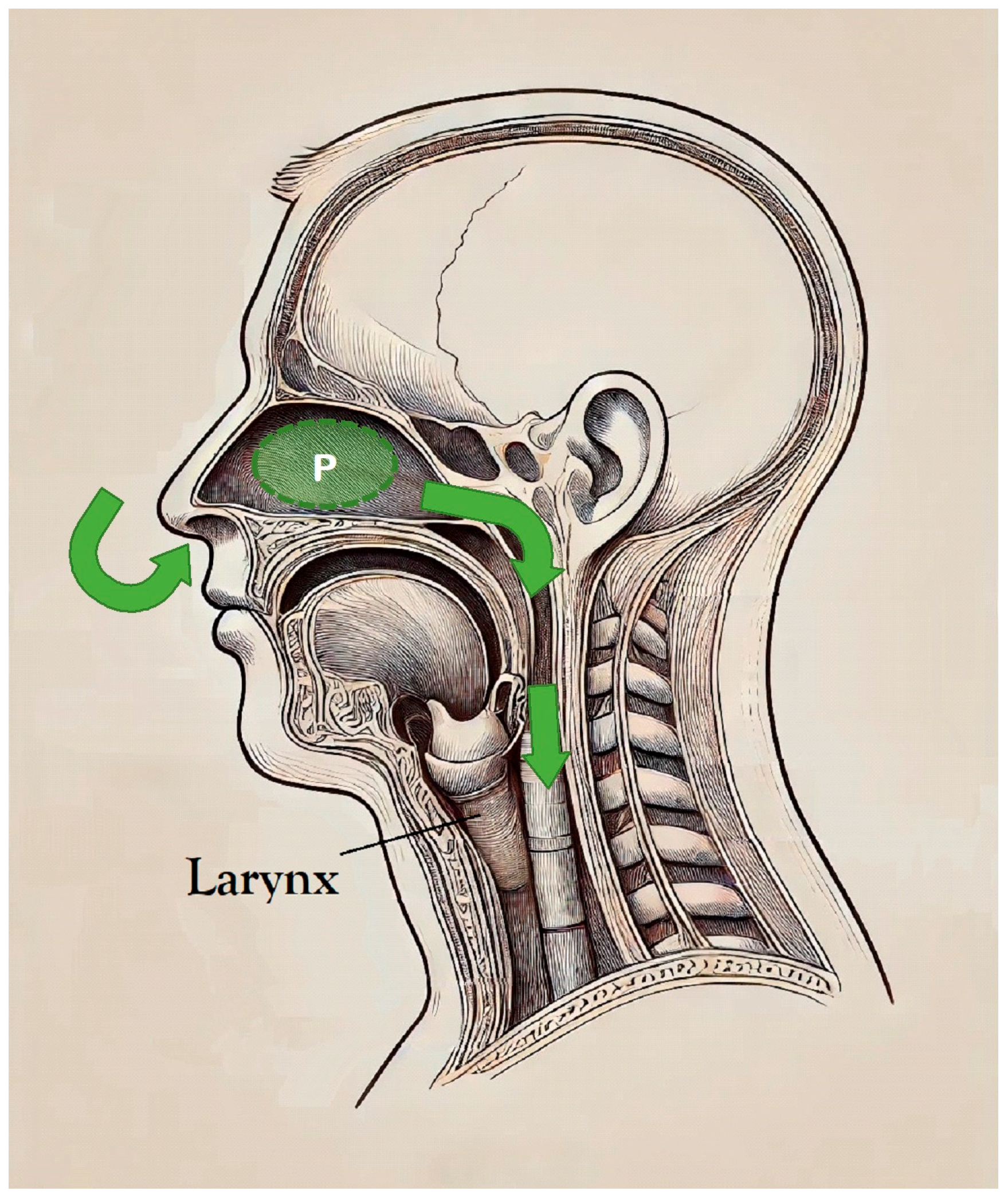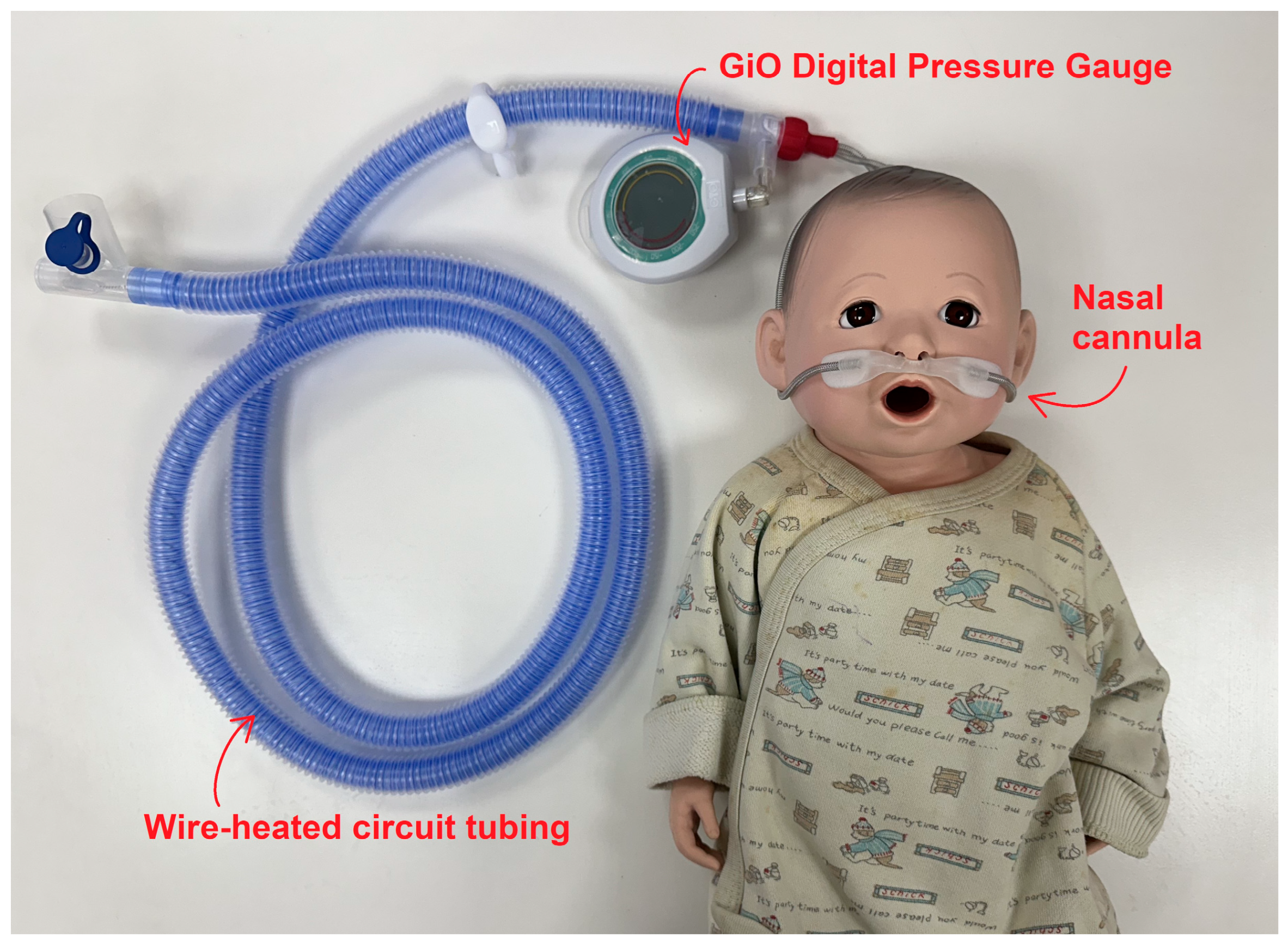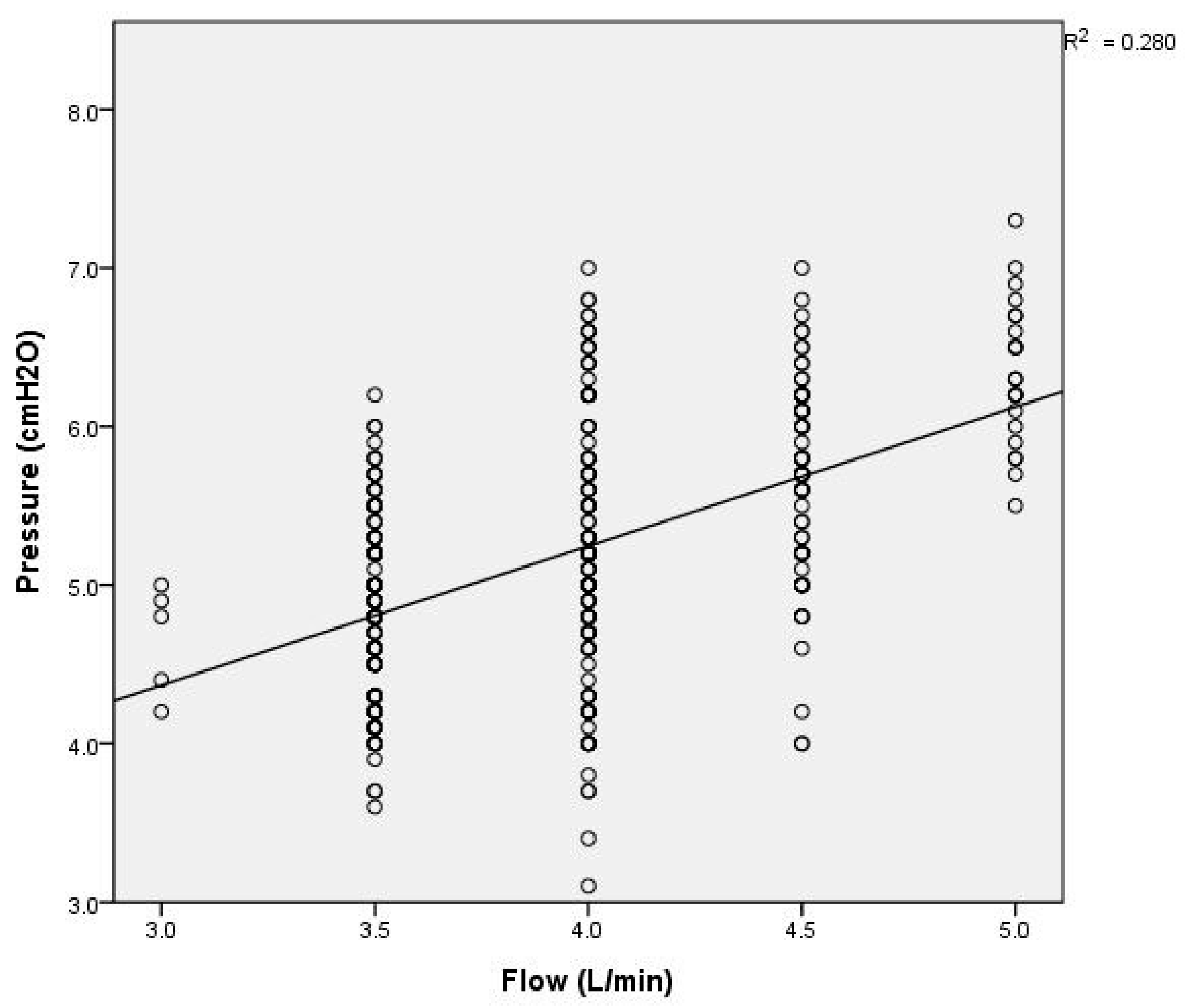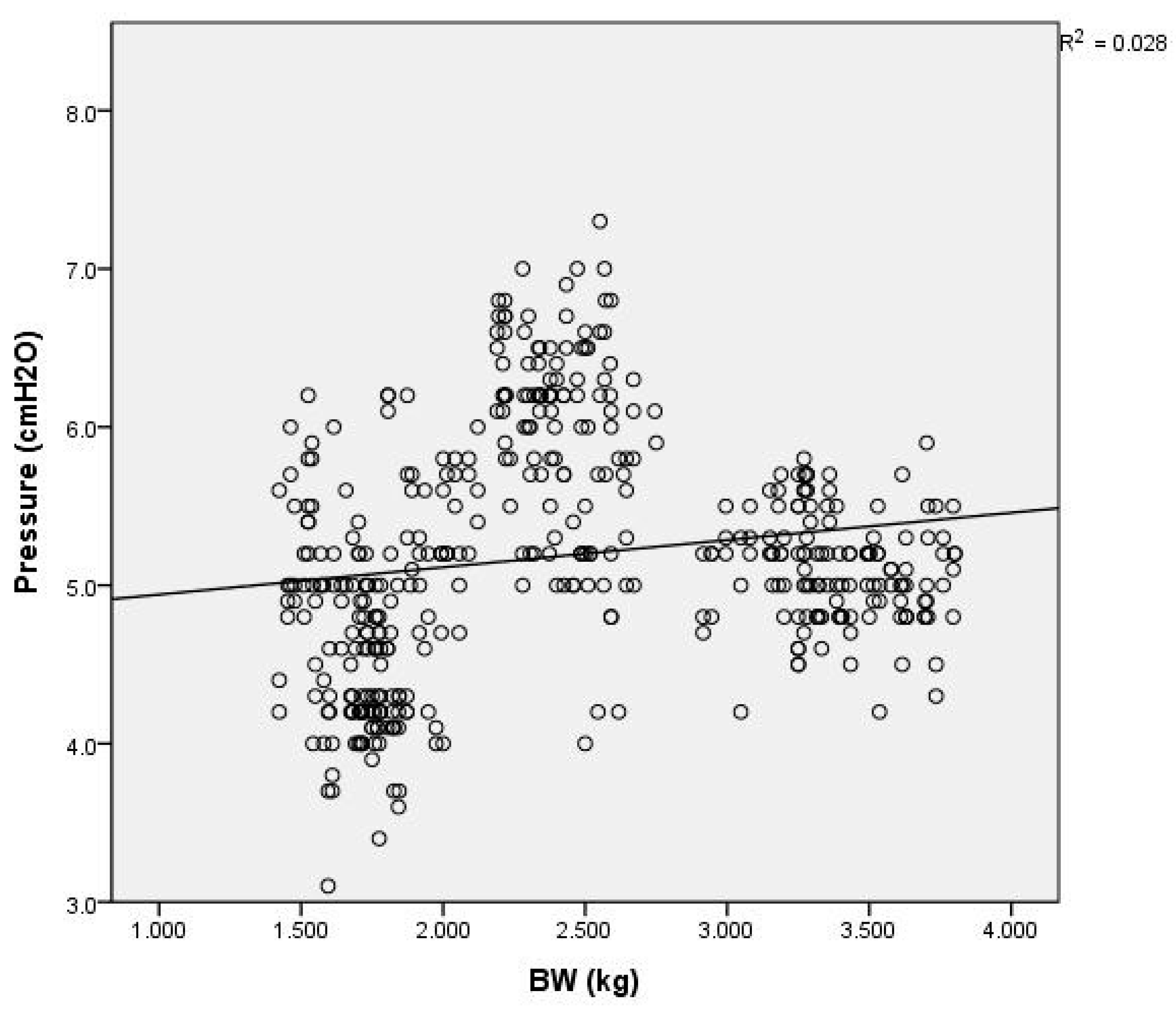Evaluating Pressure Variability and Influencing Factors during High-Flow Nasal Cannula Therapy in Premature Infants
Abstract
1. Introduction
2. Materials and Methods
2.1. Patients
2.2. Pressure Measurements during HHHFNC Therapy
2.3. Covariates and Outcome Measures
2.4. Statistical Analysis
3. Results
3.1. Participants
3.2. Analysis of Factors That Affect Generated Pressure of HHHFNCs
3.3. Adverse Events
4. Discussion
5. Conclusions
Author Contributions
Funding
Institutional Review Board Statement
Informed Consent Statement
Data Availability Statement
Acknowledgments
Conflicts of Interest
References
- Badiee, Z.; Eshghi, A.; Mohammadizadeh, M. High flow nasal cannula as a method for rapid weaning from nasal continuous positive airway pressure. Int. J. Prev. Med. 2015, 6, 33. [Google Scholar] [CrossRef]
- Soonsawad, S.; Tongsawang, N.; Nuntnarumit, P. Heated humidified high-flow nasal cannula for weaning from continuous positive airway pressure in preterm infants: A randomized controlled trial. Neonatology 2016, 110, 204–209. [Google Scholar] [CrossRef]
- Holleman-Duray, D.; Kaupie, D.; Weiss, M.G. Heated humidified high-flow nasal cannula: Use and a neonatal early extubation protocol. J. Perinatol. 2007, 27, 776–781. [Google Scholar] [CrossRef] [PubMed]
- Bouaram, B.A.; Fernandes, C.J. Heated, humidified high-flow nasal cannula therapy: Yet another way to deliver continuous positive airway pressure? Pediatrics 2008, 122, 218–219. [Google Scholar] [CrossRef]
- Dani, C.; Pratesi, S.; Migliori, C.; Bertini, G. High flow nasal cannula therapy as respiratory support in the preterm infant. Pediatr. Pulmonol. 2009, 44, 629–634. [Google Scholar] [CrossRef] [PubMed]
- Moller, W.; Feng, S.; Domanski, U.; Franke, K.J.; Celik, G.; Bartenstein, P.; Becker, S.; Meyer, G.; Schmid, O.; Eickelberg, O.; et al. Nasal high flow reduces dead space. J. Appl. Physiol. 2017, 122, 191–197. [Google Scholar] [CrossRef]
- Sreenan, C.; Lemke, R.P.; Hudson-Mason, A.; Osiovich, H. High-flow nasal cannulae in the management of apnea of prematurity: A comparison with conventional nasal continuous positive airway pressure. Pediatrics 2001, 107, 1081–1083. [Google Scholar] [CrossRef]
- Davis, P.G.; Henderson-Smart, D.J. Nasal continuous positive airways pressure immediately after extubation for preventing morbidity in preterm infants. Cochrane Database Syst. Rev. 2003, CD000143. [Google Scholar] [CrossRef] [PubMed]
- Jatana, K.R.; Oplatek, A.; Stein, M.; Phillips, G.; Kang, D.R.; Elmaraghy, C.A. Effects of nasal continuous positive airway pressure and cannula use in the neonatal intensive care unit setting. Arch. Otolaryngol. Head. Neck Surg. 2010, 136, 287–291. [Google Scholar] [CrossRef] [PubMed]
- Osman, M.; Elsharkawy, A.; Abdel-Hady, H. Assessment of pain during application of nasal-continuous positive airway pressure and heated, humidified high-flow nasal cannulae in preterm infants. J. Perinatol. 2015, 35, 263–267. [Google Scholar] [CrossRef] [PubMed]
- Roberts, C.T.; Manley, B.J.; Dawson, J.A.; Davis, P.G. Nursing perceptions of high-flow nasal cannulae treatment for very preterm infants. J. Paediatr. Child. Health 2014, 50, 806–810. [Google Scholar] [CrossRef] [PubMed]
- Di Mauro, A.; Capozza, M.; Cotugno, S.; Tafuri, S.; Bianchi, F.P.; Schettini, F.; Panza, R.; Laforgia, N. Nasal high flow therapy in very low birth weight infants with mild respiratory distress syndrome: A single center experience. Ital. J. Pediatr. 2017, 43, 116. [Google Scholar] [CrossRef]
- Shimizu, D.; Araki, S.; Kawamura, M.; Kuwamura, M.; Suga, S.; Miyake, F.; Ichikawa, S.; Kinjo, T.; Kusuhara, K. Impact of high flow nasal cannula therapy on oral feeding in very low birth weight infants with chronic lung disease. J. UOEH 2019, 41, 131–138. [Google Scholar] [CrossRef] [PubMed][Green Version]
- Gray, S.; Lee, B.; Levy, M.; Rungvivatjarus, T.; Patel, A.; Mannino Avila, E.; Fisher, E.; Rhee, K.E. Oral feeding on high-flow nasal cannula in children hospitalized with bronchiolitis. Hosp. Pediatr. 2023, 13, 159–167. [Google Scholar] [CrossRef] [PubMed]
- Miller, A.G.; Gentle, M.A.; Tyler, L.M.; Napolitano, N. High-flow nasal cannula in pediatric patients: A survey of clinical practice. Respir. Care 2018, 63, 894–899. [Google Scholar] [CrossRef] [PubMed]
- Mikalsen, I.B.; Davis, P.; Oymar, K. High flow nasal cannula in children: A literature review. Scand. J. Trauma Resusc. Emerg. Med. 2016, 24, 93. [Google Scholar] [CrossRef] [PubMed]
- Finer, N.N.; Mannino, F.L. High-flow nasal cannula: A kinder, gentler cpap? J. Pediatr. 2009, 154, 160–162. [Google Scholar] [CrossRef] [PubMed]
- Schmid, F.; Olbertz, D.M.; Ballmann, M. The use of high-flow nasal cannula (hfnc) as respiratory support in neonatal and pediatric intensive care units in germany-a nationwide survey. Respir. Med. 2017, 131, 210–214. [Google Scholar] [CrossRef] [PubMed]
- Chen, J.; Lin, Y.; Du, L.; Kang, M.; Chi, X.; Wang, Z.; Liu, Y.; Gao, W.; Yang, J.; Chen, Y. The comparison of hhhfnc and ncpap in extremely low-birth-weight preterm infants after extubation: A single-center randomized controlled trial. Front. Pediatr. 2020, 8, 250. [Google Scholar] [CrossRef] [PubMed]
- Kadivar, M.M.; Mosayebi, Z.M.; Razi, N.M.; Nariman, S.M.; Sangsari, R.M. High flow nasal cannulae versus nasal continuous positive airway pressure in neonates with respiratory distress syndrome managed with insure method: A randomized clinical trial. Iran. J. Med. Sci. 2016, 41, 494–500. [Google Scholar]
- Sivieri, E.M.; Gerdes, J.S.; Abbasi, S. Effect of hfnc flow rate, cannula size, and nares diameter on generated airway pressures: An in vitro study. Pediatr. Pulmonol. 2013, 48, 506–514. [Google Scholar] [CrossRef] [PubMed]
- Wilkinson, D.J.; Andersen, C.C.; Smith, K.; Holberton, J. Pharyngeal pressure with high-flow nasal cannulae in premature infants. J. Perinatol. 2008, 28, 42–47. [Google Scholar] [CrossRef] [PubMed]
- Kubicka, Z.J.; Limauro, J.; Darnall, R.A. Heated, humidified high-flow nasal cannula therapy: Yet another way to deliver continuous positive airway pressure? Pediatrics 2008, 121, 82–88. [Google Scholar] [CrossRef]
- Liew, Z.; Fenton, A.C.; Harigopal, S.; Gopalakaje, S.; Brodlie, M.; O’Brien, C.J. Physiological effects of high-flow nasal cannula therapy in preterm infants. Arch. Dis. Child. Fetal Neonatal Ed. 2020, 105, 87–93. [Google Scholar] [CrossRef] [PubMed]
- Hebbink, R.H.J.; Duiverman, M.L.; Wijkstra, P.J.; Hagmeijer, R. Upper airway pressure distribution during nasal high-flow therapy. Med. Eng. Phys. 2022, 104, 103805. [Google Scholar] [CrossRef] [PubMed]






| Mean | Median | |
|---|---|---|
| Birth gestation (weeks) | 28.33 ± 2.61 | 28.4 |
| Birth weight (g) | 1102 ± 327.53 | 1153 |
| 1 min Apgar score | 3.89 ± 1.76 | 4 |
| 5 min Apgar score | 6 ± 2.24 | 6 |
| Respiratory support with HHHFNCs | ||
| PMA (weeks) | 46.67 ± 26.83 | 30 |
| PMA (days) | 244.44 ± 19.74 | 238 |
| Current weight (g) | 2083 ± 11 | 1917 |
| Flow (L/min) | 3.83 ± 0.56 | 4 |
| Pressure (cmH2O) | 4.89 ± 0.81 | 5 |
| Duration (days) | 20.89 ± 4.73 | 21 |
| Participant | Mean | Median | Std. Deviation | Coefficient of Variation | |
|---|---|---|---|---|---|
| Mean Centered | Median Centered | ||||
| 1 | 4.995 | 5.000 | 0.338 | 6.8% | 6.8% |
| 2 | 2.450 | 2.450 | 0.316 | 13.2% | 13.1% |
| 3 | 1.333 | 1.333 | 0.168 | 11.5% | 16.1% |
| 4 | 1.250 | 1.250 | 0.169 | 13.5% | 13.5% |
| 5 | 0.667 | 0.667 | 0.087 | 12.2% | 14.8% |
| 6 | 0.857 | 0.857 | 0.081 | 9.3% | 9.7% |
| 7 | 0.638 | 0.625 | 0.033 | 5.2% | 5.7% |
| 8 | 0.667 | 0.667 | 0.080 | 12.6% | 12.5% |
| 9 | 0.518 | 0.518 | 0.060 | 11.9% | 12.0% |
Disclaimer/Publisher’s Note: The statements, opinions and data contained in all publications are solely those of the individual author(s) and contributor(s) and not of MDPI and/or the editor(s). MDPI and/or the editor(s) disclaim responsibility for any injury to people or property resulting from any ideas, methods, instructions or products referred to in the content. |
© 2024 by the authors. Licensee MDPI, Basel, Switzerland. This article is an open access article distributed under the terms and conditions of the Creative Commons Attribution (CC BY) license (https://creativecommons.org/licenses/by/4.0/).
Share and Cite
Ho, F.-C.; Lin, C.-Y.; Chang, A.-S.; Yeh, C.-Y.; Chen, H.-L. Evaluating Pressure Variability and Influencing Factors during High-Flow Nasal Cannula Therapy in Premature Infants. Children 2024, 11, 995. https://doi.org/10.3390/children11080995
Ho F-C, Lin C-Y, Chang A-S, Yeh C-Y, Chen H-L. Evaluating Pressure Variability and Influencing Factors during High-Flow Nasal Cannula Therapy in Premature Infants. Children. 2024; 11(8):995. https://doi.org/10.3390/children11080995
Chicago/Turabian StyleHo, Fong-Cheng, Chia-Ying Lin, Ane-Shu Chang, Ching-Yi Yeh, and Hsiu-Lin Chen. 2024. "Evaluating Pressure Variability and Influencing Factors during High-Flow Nasal Cannula Therapy in Premature Infants" Children 11, no. 8: 995. https://doi.org/10.3390/children11080995
APA StyleHo, F.-C., Lin, C.-Y., Chang, A.-S., Yeh, C.-Y., & Chen, H.-L. (2024). Evaluating Pressure Variability and Influencing Factors during High-Flow Nasal Cannula Therapy in Premature Infants. Children, 11(8), 995. https://doi.org/10.3390/children11080995





